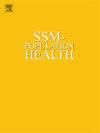印尼成人婚姻转变对体重变化的影响:一项纵向研究
IF 3.1
2区 医学
Q1 PUBLIC, ENVIRONMENTAL & OCCUPATIONAL HEALTH
引用次数: 0
摘要
本研究调查印尼20岁以上成人婚姻转变对体重变化的影响。该研究假设,从未婚到已婚的转变会显著增加体重。我们使用多元线性回归分析了印度尼西亚家庭生活调查第4和第5波的26386名成年人。该分析是基于性别(男性和女性)和世代(年轻人和老年人)建模的。分析控制了社会人口学、健康行为和心理方面的因素。结果显示,与那些一直未婚的人相比,从未婚转变为已婚的人在整个样本和亚组分析中显著增加了2.30公斤(kg)的体重。在整个样本和亚组分析中,从分居/丧偶/离婚到已婚的转变也显著增加了体重,但男性除外。相比之下,从已婚到分居/离婚/丧偶的转变,在整个样本中,男性和年轻人的体重都有所下降。已婚男性和年轻一代的体重下降了1.31公斤,离婚/分居的男性、年长和年轻一代的体重下降了1.31公斤,整个样本和年轻一代的体重下降了1.31公斤。研究结果与生命历程理论和现有研究一致,表明结婚后生活方式的改变,包括饮食习惯和体育锻炼的减少,可能会导致体重增加。有必要针对新婚夫妇采取健康干预措施,鼓励健康行为,如保持身体活动,并在婚姻早期做出有营养的饮食选择。本文章由计算机程序翻译,如有差异,请以英文原文为准。
The effect of marital transition on body weight changes among Indonesian adults: A Longitudinal study
This research investigated the effect of marital transition on body weight changes among Indonesian adults aged 20 year old or older. It hypothesized that transition from unmarried to married adults significantly increased the body weight. We analyzed 26,386 adults from Indonesian Family Life Survey waves 4 and 5 using multiple linear regression with wide form of longitudinal data. The analysis was modelled based on sex (male and female) and generation (younger and older). The analysis controlled for sociodemographic, health behaviors, and psychological aspect. The results revealed that compared to those remain never married, transition from never married to be married significantly increased 2.30 Kilograms (kg) body weight for the whole sample as well as for sub-groups analysis. The transition from separated/widowed/divorced to married also significantly increased body weight in the whole sample and sub-group analysis, except male. In contrast, the transition from married to separated/divorced/widowed decreased body weight among the whole sample, males, and younger. The body weight was found decreased 1.31 kg among males and younger generation who remained married decreased, among males, older, and younger generations who remained divorced/separated, and among the whole sample and younger generations who remained widowed. Findings align with the life course theory and existing researches indicating that lifestyle changes following marriage, including eating habits and reduced physical activity, may contribute to weight gain. Health interventions targeting newlyweds, encouraging healthy behaviors such as maintaining physical activity and making nutritious dietary choices early in marriage are needed.
求助全文
通过发布文献求助,成功后即可免费获取论文全文。
去求助
来源期刊

Ssm-Population Health
PUBLIC, ENVIRONMENTAL & OCCUPATIONAL HEALTH-
CiteScore
6.50
自引率
2.10%
发文量
298
审稿时长
101 days
期刊介绍:
SSM - Population Health. The new online only, open access, peer reviewed journal in all areas relating Social Science research to population health. SSM - Population Health shares the same Editors-in Chief and general approach to manuscripts as its sister journal, Social Science & Medicine. The journal takes a broad approach to the field especially welcoming interdisciplinary papers from across the Social Sciences and allied areas. SSM - Population Health offers an alternative outlet for work which might not be considered, or is classed as ''out of scope'' elsewhere, and prioritizes fast peer review and publication to the benefit of authors and readers. The journal welcomes all types of paper from traditional primary research articles, replication studies, short communications, methodological studies, instrument validation, opinion pieces, literature reviews, etc. SSM - Population Health also offers the opportunity to publish special issues or sections to reflect current interest and research in topical or developing areas. The journal fully supports authors wanting to present their research in an innovative fashion though the use of multimedia formats.
 求助内容:
求助内容: 应助结果提醒方式:
应助结果提醒方式:


